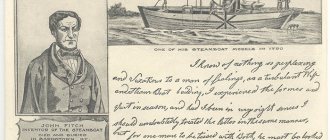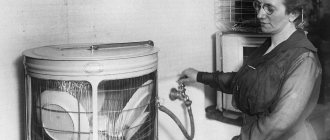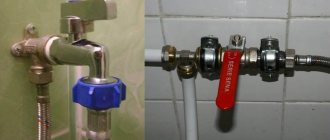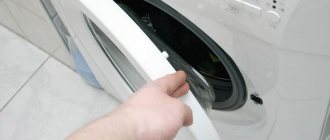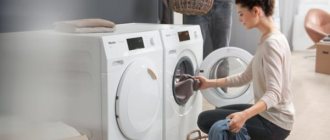Who invented the first automatic washing machine? SMA can rightly be called a real invention, which is on the same level as a wheel or a car. This piece of household appliance allowed me to save a lot of time on household chores and spend it on more important tasks.
Currently, 82% of women around the world use automatic machines. However, few know who to thank for this. To correct this shortcoming, below is a story about who exactly invented the washing machine.
- The first washing machine model in the world
- Washing machines in America
- Activator machines
- Automatic washing machines
- Conclusion
- Catalog of washing machines with reviews
The first washing machine model in the world
Who actually designed the washing machine and at what time is not known for certain. Most likely, the name of its author will remain a secret, since there is practically no information about it.
In ancient times, powerful civilizations had already ceased to exist and few details remained about their everyday life. So, they washed using a special hand-held board.
Washboard
Today, only facts from the new history of washing machines have been preserved. So, in 1797 in New Hampshire, Nathaniel Briggs constructed a tub from wood, in which the frame rotated clockwise using a special handle. To set such a mechanism in motion, it was necessary to invest a lot of effort, so the invention remained unnoticed.
Stages of evolution
- 20s of XX century. Wooden tanks have been replaced by metal enameled analogues.
- 30s. At this time, pumps powered by electricity began to be used. A timer was added to the design of the machines.
- 1949 This year the first programmer was invented and the production of the first automatic washing machine was launched.
- 50s For the first time, the function of automatic laundry spinning has been implemented.
- '78. A model with a microprocessor has been created.
- The beginning of the 21st century – integration of SMA into the “smart home” system.
From the early 90s to the present day, manufacturers have been supplementing and improving the design of washing machines, adding options and functions, and unique innovative technologies.
Washing machines in America
Back in 1851, the American engineer King proposed a device for housewives with a handle that they needed to rotate to set the frame in motion, spinning the laundry. He also filed a patent for a “washing” machine.
Expert opinion
I work in the household appliance repair industry. Extensive experience in restoring washing machines and dishwashers.
Ask a Question
To be honest, the creator just had the idea to slightly modify the churn so that it would allow washing clothes. Such a device had 5 special holes for the exit of dirty water, and clean water had to be poured in manually.
At that time, this was a significant leap forward. Then improved models began to appear. One of them was a machine equipped with a manual drive, which later went into mass production.
First washing machine
It was offered by the American Blackstone, who set the price for it at $2.5. Since he was the first to launch serial production, he is usually called the creator of washing machines.
His invention was distinguished by the presence of a tank - it had to be rotated manually. However, it also had two rollers that allowed for spinning. So, the laundry was passed through them by rotating the handle and got rid of excess moisture. The spinning device was developed somewhat earlier - in 1861.
As of 1875, patents had been issued in the States for almost 2,000 models of various designs to make washing easier. However, most of them turned out to be inoperative or have low efficiency and reliability.
How were things in Europe?
However, it was due to the European invention that 1900 is considered the beginning of the history of modern washing machines. Its design was almost no different from that proposed by King, although it was a little more perfect.
Thus, the German company Miele & Cie decided to produce butter churns, which were tubs made of wood, the rotation of which was carried out using a manual drive. The local engineer K. Miele modified these models so that they could be washed.
Miele washing machine
After this, it became clear what a washing machine should be like. Housewives positively assessed this model and began to buy it up at a fantastic speed. Although we are talking about the following modifications, since few people liked the first one due to its appearance.
The legend of soap
There is even one interesting ancient legend regarding the invention of soap by people. According to legend, the Latin word sapo (soap) comes from the name of Mount Sapo in Ancient Rome. In this place, according to legend, sacrifices to the gods were once upon a time made. The fat released during the burning of animals was subsequently washed away by rain into the Tiber flowing under the Tiber mountain. Soon, ancient housewives noticed that clothes were washed best in the river right next to the place of sacrifice.
Activator machines
Since farmers in America and peasants in Western Europe began to use steam engines much earlier than factories in cities, they were the first to come up with the idea of simplifying the work of their wives.
So, they massively designed strong barrels, with a rotating crosspiece (activator) located inside. It received energy for movement through a drive belt or toothed transmission shafts.
Expert opinion
I work in the household appliance repair industry. Extensive experience in restoring washing machines and dishwashers.
Ask a Question
Such devices were quite stylish, and were constantly being improved. For this reason, today such washing machines occupy a place of honor in antique museums. They also became the prototype of semi-automatic machines, which became possible thanks to another American, Fisher.
Based on existing developments, this entrepreneur tried in 1908 to equip a washing machine with an electric motor. According to his idea, the model could be suitable for household use, but his new product was not successful.
This was due to the high danger of operation, since the moving elements were located outside. However, the idea became a breakthrough because it allowed us to avoid hard work.
Activator washing machine
Further, development began more rapidly and in those years several companies appeared that are still known today:
- Upton in 1911 began to build a small factory producing semi-automatic machines. Over time, his brainchild turned into the world-class company Whirlpool.
- Italian Antonio Zanussi also decided to start producing electric washing machines in 1916. Having started producing semi-automatic machines, he was able to make his company the largest in Italy. Zanussi later reached world level.
- The Koreans also did not stand still - there Lee Byung Chol completed the construction of a rice mill in 1930, giving rise to the future Samsung. The company later also began producing washing machines.
As of 1940-1950, there were already almost 2 thousand companies in Europe, Asia and America that were engaged in the production of washing machines. Although semi-automatic machines have reduced the effort required for washing by tens of times and made this process easier, full automatic machines have not appeared soon.
Do you store laundry in the washing machine?
Oh yes! No.
When did serial production begin?
The first person to launch a mechanical washing device was William Blackstone. This inventor invented and assembled his own machine especially for his wife’s birthday in 1874. Later, convenient mechanical equipment began to bring the family a good income.
In Europe, mechanical washing machines first began to be produced in 1900. The inventor of new equipment designed to remove dirt from clothes in this part of the world was the German Karl Miele. The machine he assembled worked on the basis of a butter churn. A small batch of such mechanisms was brought to Russia at that time.
Automatic washing machines
The market at the end of 1950 could only offer semi-automatic models, especially in the USA and European countries. However, a year later the situation changed dramatically, since at that time the first machine gun appeared. The design of the device was similar to modern models, as it was equipped with a spinning mechanism.
The machine was equipped with two toggle switches - one to start washing, the second to dry. Although modes had to be switched manually, this was another step forward.
Soviet semi-automatic
Already in 1962, the Miele corporation developed the first automatic machine, to control which you only had to press one switch. The main disadvantage of the models of that time was that the spin was rather weak, since the drum rotated at a maximum speed of 600 rpm.
Although in 1970 a device was introduced with a speed of 1000 revolutions. The washing machine was very noisy, however, it performed its functions at the proper level.
Already in 1978, the same Mila proposed a project for a real machine that received microprocessor control. Then the engineers presented a finished model, in which it was no longer necessary to switch modes. The product became a real prototype of modern solutions and was able to carry out a full washing cycle.
Further, manufacturers began to improve their designs, gradually adding new features, including:
- drying;
- easy ironing;
- automatic weighing of clothes;
- smart wash;
- for individual fabric.
Modern SMA
In modern models, discrete logic has been replaced by Fuzzy Logic (read more about it in the corresponding article). Its distinctive feature is the mass of parameters that the user can set, as well as information that is read by sensors and reported to the control unit.
In the latest developments, Fuzzy Logic has been replaced by UseLogic - the system analyzes all parameters of the laundry, determining the optimal washing process. During the mode itself, processes are analyzed, examined and adjusted - this reduces the consumption of resources and detergents. At the same time, the quality of washing and the impeccable appearance of the laundry are maintained.
Clear Water sensor is a development that analyzes water contamination. If the sensor tells the board that the water is too cloudy, the system will automatically initiate an additional rinse.
We can discuss the cars of our time endlessly, but this is a topic for a separate article. And you have already learned the most interesting things about the history of the emergence and development of this industry.
Her time has just passed
The Soviet mini-washing machine began to lose its conquered positions only in the “roaring nineties”, when a flow of foreign household appliances of a new generation poured into the country.
— The main problem was that “Malyutka” does not have any automation. Modern housewives are accustomed to selecting different washing modes by pressing a couple of buttons, but with this mini-washer everything is very simple: turn it on and off. One mode for everything. Plus, there is no spin, for example. In general, her time has simply ended,” says Sergei Ageev.
By 1996, the release of “Malyutok” dropped to one and a half thousand per month, and soon stopped altogether. But many housewives still remember these machines with warmth. Although it was necessary to place boards under the mini-washer so that it did not vibrate too much, and the sheets sometimes tore during washing, it was still a light, trouble-free and cheap machine (38 rubles in “pre-perestroika” prices) in the seventies and eighties of the last century greatly helped out many millions of Russian families.
Article on the topic: Where are the shipping bolts in the washing machine?
Opinions
Evgeny Roizman, mayor of Yekaterinburg (LJ entry):
“This “Baby” brought so much joy to people! Every family had it. Our mothers did most of the washing by hand. Do you remember when there were still troughs like this? They rested the washboard there and rubbed it, washing their hands. And suddenly - “Baby”! And we do it ourselves. Who wouldn't be happy?
Rudolf Grashin, OG journalist:
— “Malyutka” was with us during our student years. Then almost every evening I had to wash baby diapers and nappies (there were no disposable diapers at that time). There was always not enough time, it was necessary to wash quickly... The Malyutka did not have any washing program - the machine was turned on and off with a toggle switch. Now this looks like a disadvantage, but for us then it was a plus, since it allowed us to greatly speed up the whole process. The water after washing and rinsing could be poured into the bathroom at once, simply by turning the machine over. Washing went quickly and usually took only half an hour. If the machine had a program, then probably only one cycle would take so much time. Why wash diapers for 30 minutes?
Plot
“Legendary Sverdlovsk brands” The Sverdlovsk region produced both excellent food products and high-quality consumer goods. To remember them and believe in ourselves, in the fact that we can do a lot ourselves, is the goal of this series of publications.
Where it all began
Background to the emergence of washing technology
Before the active development of scientific and technological progress, washing methods were quite primitive.
The name of the first inventor of the machine is still unknown, since applications for its registration were received regularly and in large quantities. The devices were not much like modern ones, but they could confidently be called prerequisites. Article on the topic: Indesit washing machine trays where to pour stain remover
At the end of the 18th century, the washboard appeared, which served people for many years. It was widespread in Soviet times.
During these same years, the American Nathaniel Briggs invented the washing device. It was in the form of a wooden tub with a rotating frame. The high labor costs did not justify the purpose of the apparatus.
The appearance of the first washing machines
The patented device appeared in the mid-19th century. The world's first washing machine was created by American inventor James King. Outwardly, it was very reminiscent of a modern device, despite the fact that it was manually operated.
From that time on, improvements in the washing process began to occur at an accelerated pace. Until 71 of the 19th century, there were about 2 thousand patents for devices in America. Many washing machines were not suitable for performing their basic functions. Their operation did not last long, since the reliability of the device left much to be desired.
One of the first laundries was opened by an inventor from California in 51 of the 19th century. He designed a machine that could wash 10-15 items at a time. No human labor was used to operate the device. It was harnessed to 10 mules. The Californian charged a certain amount for washing clothes and thereby earned his living.
Launch of washing equipment into mass production
The first person to invent a washing machine and put it into mass production was William Blackstone. It was manually operated and sold for two and a half dollars per unit. The inventor gave the first constructed model to his wife on her birthday. The industrial enterprise founded by Blackstone continues to operate to this day.
Related article: How to load dishes into an electrolux dishwasher
Since the laundry needed to be spun after washing, and this procedure also required considerable effort, a device was invented that made it easy to get rid of excess water. It consisted of two rollers rotating towards each other. Wet laundry passed through them and was wrung out, while you had to turn the handle. Not long ago people stopped using this invention.
Washing appliances with motor
In Europe, washing machines began to appear at the beginning of the 20th century. The design began to use a motor, which initially worked using combustible fuel. But the gasoline-powered mechanism did not take root, since the smoke and smell emanating from it adversely affected the cleanliness and freshness of things.
Subsequently, the Germans improved production technology, which led to the emergence of the first electric washing machine. The creator of this device, called "Thor", is Alva Fischer. The structure was made of wood and looked like a drum. Washing was carried out with rotating movements eight times in each direction.
